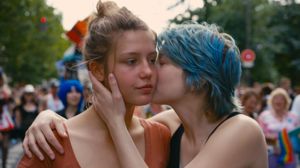Many people are obsessing over the lesbian sex scenes in Blue is the Warmest Colour. They're too graphic! Too long! Too hetero! The media focus, meanwhile, has shifted to extratextual analysis about the on-set treatment of the actresses by director Abdellatif Kechiche. But you seem to have escaped the controversy. Not surprising, perhaps, since many people outside the industry don't understand the role of a First A.D. Well, lucky you. Because this film deserves to be seen and discussed, but you should probably also bear some responsibility for the faults.
As you know, in filmmaking the director is the top of the creative food chain. He or she, therefore, receives an unbalanced percentage of the praise and criticism when a film is released (and shifting that balance is the very reason we write these open-letters). Blue is the Warmest Colour is receiving uncommon levels on both accounts - winning the prestigious 2013 Palme d'Or at Cannes but now suffering backlash from the story's original author, the actresses, and even parts of the LGBT community. It would be almost impossible for anyone to see the film right now without having heard something about that. Too bad, because that shouldn't be leading the discussion (or a review, for that matter); but it is. So let's clear the air.
You're obviously a trusted collaborator of Kechiche, having been an assistant director for his past three feature films: Games of Love and Chance _(2003),_ The Secret of the Grain (2007) and Black Venus (2010). You know how he works, and can no doubt anticipate his demands better than anyone. This is important, because you're the one responsible for the mechanics of the shoot, like overseeing the management of the set-ups, the schedule and the actors. If someone ever needed to pull the director aside because he was being unreasonable, it's you. However, if you treated your role more like an obedient servant, well then you probably thought anything goes in the service of art. Which it sounds like you did. So the next logical question is, was it worth it?
Speaking as a critic, yes, it was (if I was in the labour union, it might be another story). The emotional complexities Adele Exarchopoulos delivers are quite mesmerizing. If Kechiche obsessed over her performance as much as his camera lingers on her face in close-up, then it's no wonder the process felt so invasive. The film refuses to let her escape our gaze, from numerous shots of her sleeping, eating, and, of course, having sex. Her expressions and even physical appearance appear to morph before our eyes as her character struggles with her blossoming sexuality. The blue-haired object of Adele's affections, played by Lea Seydoux, is equally able in her role as an emerging artist and confident individual. Though her screen time is much more limited, it's the interplay between the two that wins the day.
Yes, Blue is The Warmest Colour is a film all about relationships (both on- and off-set, it seems). But this powerful and effective emphasis can be a problem for both the characters themselves and the filmmaking. The art direction, for example, is often painfully lazy. During a picnic scene, it feels like the whole art department gave up and just went blue - from jean jackets, to shirts, to pants, to backpacks, to hair. The characters also lose sight of their professional ambitions when their relationship gets in the way. And in that vein, maybe you felt too close to the director to ever say no to his demands.
Yet ultimately, for Blue is The Warmest Colour, the ends may have justified the means. But on a thousand other films where actress will be pressured to give more and bear more, that won't be the case. So please, don't be afraid to step in next time.
Sincerely,

Christopher






